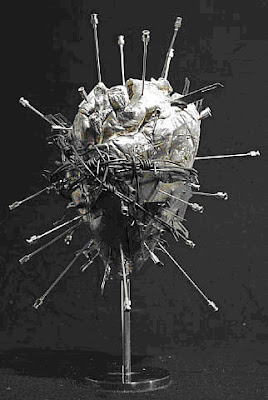On the other side of the coin
The Washington Post's chief art critic is dead on when he bashes the whole issue of:
The Rev. Martin Luther King Jr. is one of the few undoubtedly, undilutedly great figures of the 20th century. Here's a radical idea for truly doing justice to the greatness of his memory: Give him a monument that might go down in history as an equally great work of art.
According to the U.S. Commission of Fine Arts, the 28-foot-tall statue of King now being prepared on a work site in China, for eventual placement in a memorial on the Mall, doesn't fill that bill. As reported yesterday, the commission, which has final say in all such projects, recently concluded that the latest model for the sculpture evokes the socialist realist art of Stalin's Russia and Mao's China -- "a genre of political sculpture that has recently been pulled down in other countries," as the commission's chairman put it in a letter to the foundation raising funds for the memorial.
Of course giving King, or anyone for that matter "a monument that might go down in history as an equally great work of art" is not an easy assignment, as the only judge and jury there is time, not contemporary artists, critics or intelligentsia.

Gopnik makes it clear that "for the record, I'm not on board with those who complain that the King monument is being made by a foreigner. Americans have a great tradition of bringing in the best art from abroad and (eventually) making it their own: The Statue of Liberty was designed, engineered and financed by Frenchmen."
That is 98% correct, although a little research into how his example's seminal idea, construction and delivery was initially received by the American press and public does yield a few similarities with the King issue. With the passage of time, though, Gopnik's example eventually becomes a good one. But it's also not a good example in the sense that Liberty was a gift from the people of France, designed, built and paid by the French.
He's also disregarding the huge controversies and arguments raised at the time over his second example, the Viet Nam War Memorial.
In fact, it seems like the first thing that happens when a public memorial, any memorial, gets planned and discussed, is that huge chasms erupt as the various agendas, ideologies and issues arise.
Historically, huge differences of opinion and artistic controversy seems to be part of the process. It was for Lady Liberty, it was for Maya Lin's elegant wall, it was for the recent WWII Memorial, and it will be for Dr. King's statue.
Gopnik takes a stab at what would work and then backs out before making a striking observation:
What would a monument to King look like that was as forward-looking, as change-inspired as the man himself? I've no clear idea. It would probably be figurative, like most of today's best art. Abstraction has lost the power it once had to make us think in terms of big ideas; it's mostly come to have the feel of lobby decoration.
Insight into Gopnik: "figurative, like most of today's best art" - that was news to me, somewhat of a Gopnikphile... although I already knew that he thought that "Abstraction has lost the power it once had to make us think in terms of big ideas."
It will be a difficult process to select a statue for Dr. King; that much we already know, but the current Maoist-Stalinist piece of
merde being constructed inside the Chinese BORG is not the answer.
Bravo Gopnik! Read the article
here.
PS - What's with that "look" in King's face in the Lei Yixin statue anyway? And what's with the arms crossed and one hand holding a pen? (is it a pen?) - it's like Lei Yixin took Bob Dole's body and put a King head on it, where MLK is staring at the sun and squinting in discomfort?



















